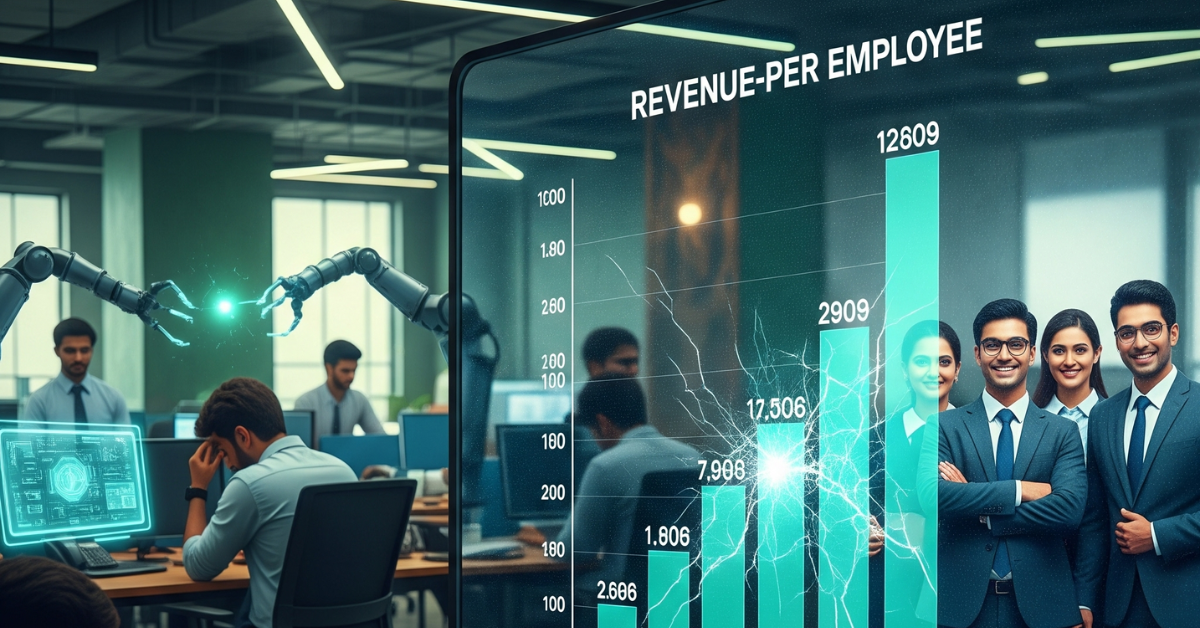
For decades, revenue per employee (RPE) has been the go-to metric for analyzing the efficiency of Indian IT companies. Investors, analysts, and even management teams often compared companies like TCS, Infosys, Wipro, and HCL on the basis of how much revenue each employee generates.
But in today’s AI-driven, digital-first era, this measure is losing its relevance. Data shows that margin performance is no longer tied directly to RPE—it’s shaped more by business mix, automation levels, and deal structures. Let’s explore why.
1. The Old Logic Behind Revenue Per Employee
Traditionally, IT services operated on a linear growth model:
- More employees → More billable hours → More revenue.
- Efficiency was measured by dividing total revenue by the number of employees.
- Higher RPE implied better utilization and pricing power.
For example, if a company generated $50,000 per employee per year, it was considered more efficient than a rival generating $35,000.
But this linear correlation breaks down in the age of automation and AI.
2. Why RPE Misleads in the Age of AI
a) Business Mix Matters More Than Headcount
- Cloud migration, cybersecurity, consulting, and productized services yield far higher margins than traditional application maintenance or testing.
- A company with fewer employees but a larger share of high-value digital projects can post better margins despite lower RPE.
b) Automation Reduces Headcount Dependency
- AI and bots can now perform tasks like code generation, testing, monitoring, and helpdesk support.
- This reduces the need for large employee bases, making per-head revenue comparisons irrelevant.
- Example: A firm automating 30% of low-end work can keep headcount stable while margins expand.
c) Deal Structures Are Evolving
- Earlier: Time-and-material (T&M) contracts tied billing to hours worked.
- Now: Fixed-price, outcome-based, and subscription-led deals are growing.
- These models allow higher margins without corresponding increases in RPE.
d) Digital Skills Outweigh Headcount Size
- Skills in AI, data analytics, and cybersecurity command premium pricing.
- One AI engineer might generate 3–4x more impact than a traditional developer.
- RPE ignores the value per skill, which is now more important than “headcount per dollar.”
3. Examples from Indian IT
- Infosys has invested heavily in automation platforms like NIA. Even if RPE flattens, margins improve because repetitive tasks are automated.
- TCS leverages its consulting-led deals and large cloud partnerships with AWS, Azure, and Google. High-value consulting boosts margins, even if RPE looks average.
- Wipro and HCLTech are focusing on productized services and engineering R&D, which create more non-linear growth—decoupling revenue growth from employee numbers.
4. How Investors Should Look at Profitability Now
Instead of focusing narrowly on RPE, investors and analysts should evaluate:
- Business Mix: Share of digital, cloud, consulting, AI-driven services.
- Automation Impact: Cost savings from AI platforms, bots, and DevOps tools.
- Deal Structures: Shift toward fixed-price, outcome-based, and annuity models.
- Margin Levers: Utilization, subcontracting costs, offshore/onshore mix.
- Employee Skill Profile: How many employees are trained in AI, cybersecurity, cloud?
5. The Bottom Line
In the age of AI and digital transformation, profitability is not about how much revenue each employee brings in—it’s about how efficiently a company delivers value using automation, skills, and deal innovation.
“Revenue per employee” was useful when IT was manpower-led. But today, business mix and automation determine margins far more than headcount efficiency.
Indian IT companies that retrain employees in digital skills, adopt AI-led automation, and pivot to fixed/outcome-based contracts will be the real winners—regardless of what their RPE number says.






